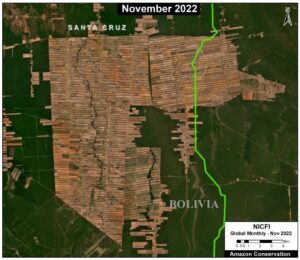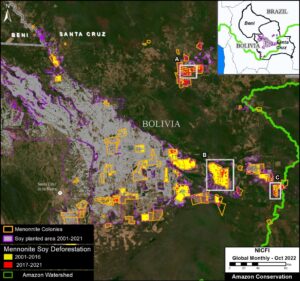New MAAP Series Follows Soy-Based Deforestation in the Bolivian Amazon
February 28, 2023
 In the first two installments of a new series monitoring soy deforestation in Bolivia, we provide more accurate estimates of total soy production-based deforestation and some of the major actors driving this significant source of deforestation.
In the first two installments of a new series monitoring soy deforestation in Bolivia, we provide more accurate estimates of total soy production-based deforestation and some of the major actors driving this significant source of deforestation.
It is generally well known that the production of commodities such as soy, oil palm, and cattle are major tropical deforestation drivers, but concise estimates of just how much deforestation occurs as a result of these commodities are often difficult to find or create.
Merging a new data set released by Global Forest Watch with high-resolution forest loss imagery, our team of GIS specialists from our Monitoring of the Andean Amazon Project (MAAP) were able to analyze the data and determine just how much forest loss has occurred.
In the first report, MAAP #179, our team documented the soy-driven deforestation of 904,518 hectares (2.2 million acres) over the past 20 years (2001-2021). This is a massive area, similar to the size of the U.S. state of Vermont. Over 100,000 hectares (250,000 acres) were deforested in just the past five years (2017-21).
In the second report, MAAP #180, our team incorporated additional data and estimated that Mennonite colonies caused nearly one quarter (23%) of the total soy deforestation over the past 20 years (210,980 hectares, or 521,344 acres) and increased to 33% over just the past 5 years.

These reports are part of a series focused on the Bolivian Amazon through a strategic collaboration between the sister organizations Conservación Amazónica – ACEAA in Bolivia and Amazon Conservation in the U.S.

